The photo for this week’s post was taken by my father on the 31st of May, 1953 in Hoxton Street, looking down Ivy Street. Above the entrance to the street is a banner which reads “Ivy Street send their greetings to the Queen”, and along the street there are flags and decorations that run the length of the visible section of the street. The photo was taken a couple of days before the Coronation of Elizabeth II on the 2nd of June 1953

This should have been such an easy location to find, however I did have my doubts and the building on the right of the entrance to the street was a bit of a mystery when I compared with the same scene today, as shown in the following photo:

Where there was a butcher in 1953, today is a shop where you can apparently buy Hoxton’s best kebab. The building on the right looked pre-war, and a view of the complete terrace of which the kebab shop is at the end, further confuses:
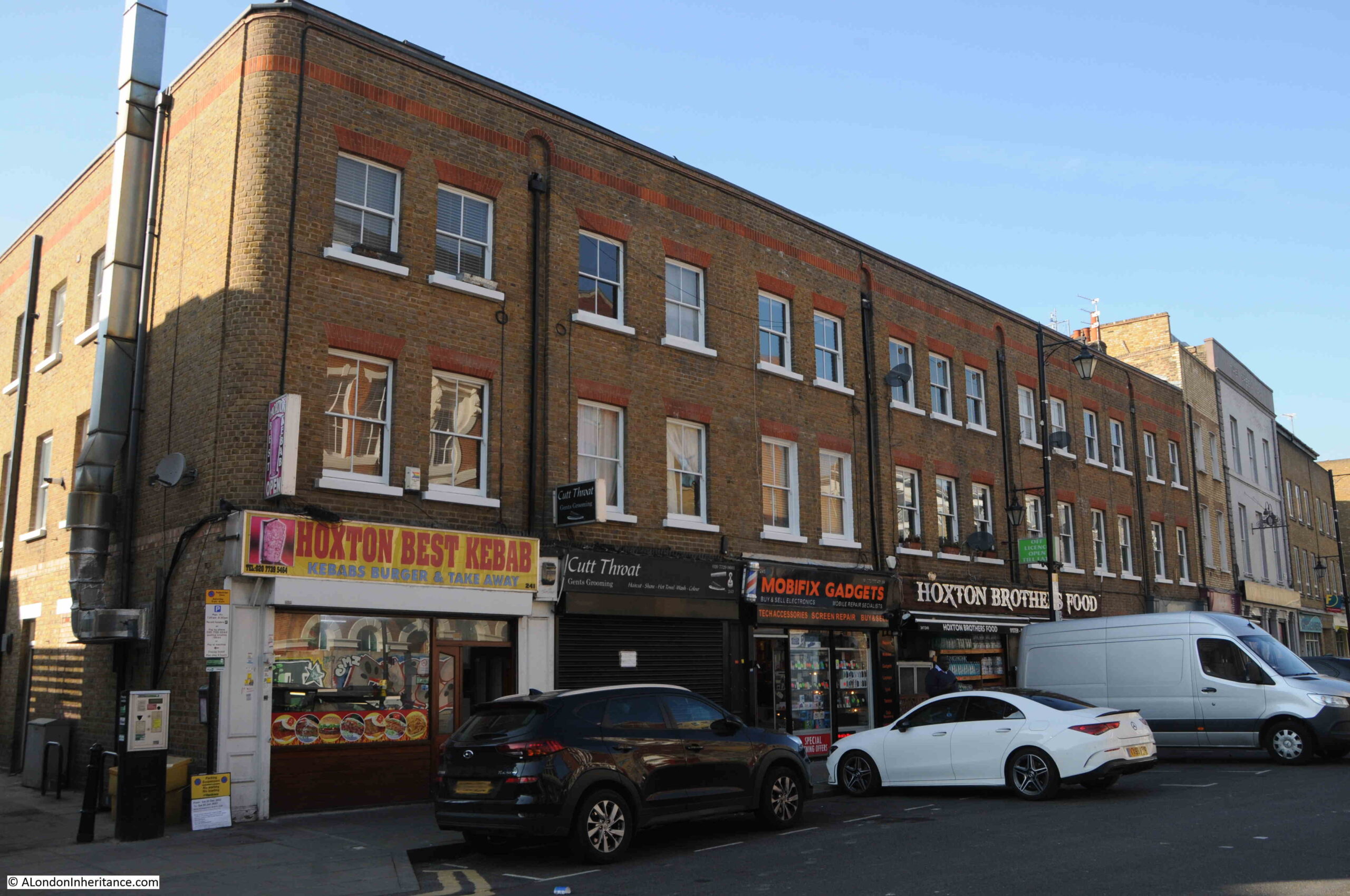
The terrace does not look of post-war design or construction. The end of terrace part with the kebab shop has the same brickwork, windows, decoration etc. as the rest of the terrace. It does not look like a recent addition to an existing terrace.
The butchers shop on the corner in my father’s photo does looks relatively new. Clean brickwork when compared with the building on the left of the entrance to Ivy Street. I did wonder whether the butcher’s shop was a temporary build following wartime bomb damage, however although there was much bomb damage in the area, the LCC Bomb Damage Maps do not show any damage to this corner building.
My father took a second photo, a short walk down Ivy Street, and although Ivy Street has changed considerably, there are a couple of features which confirm the location.
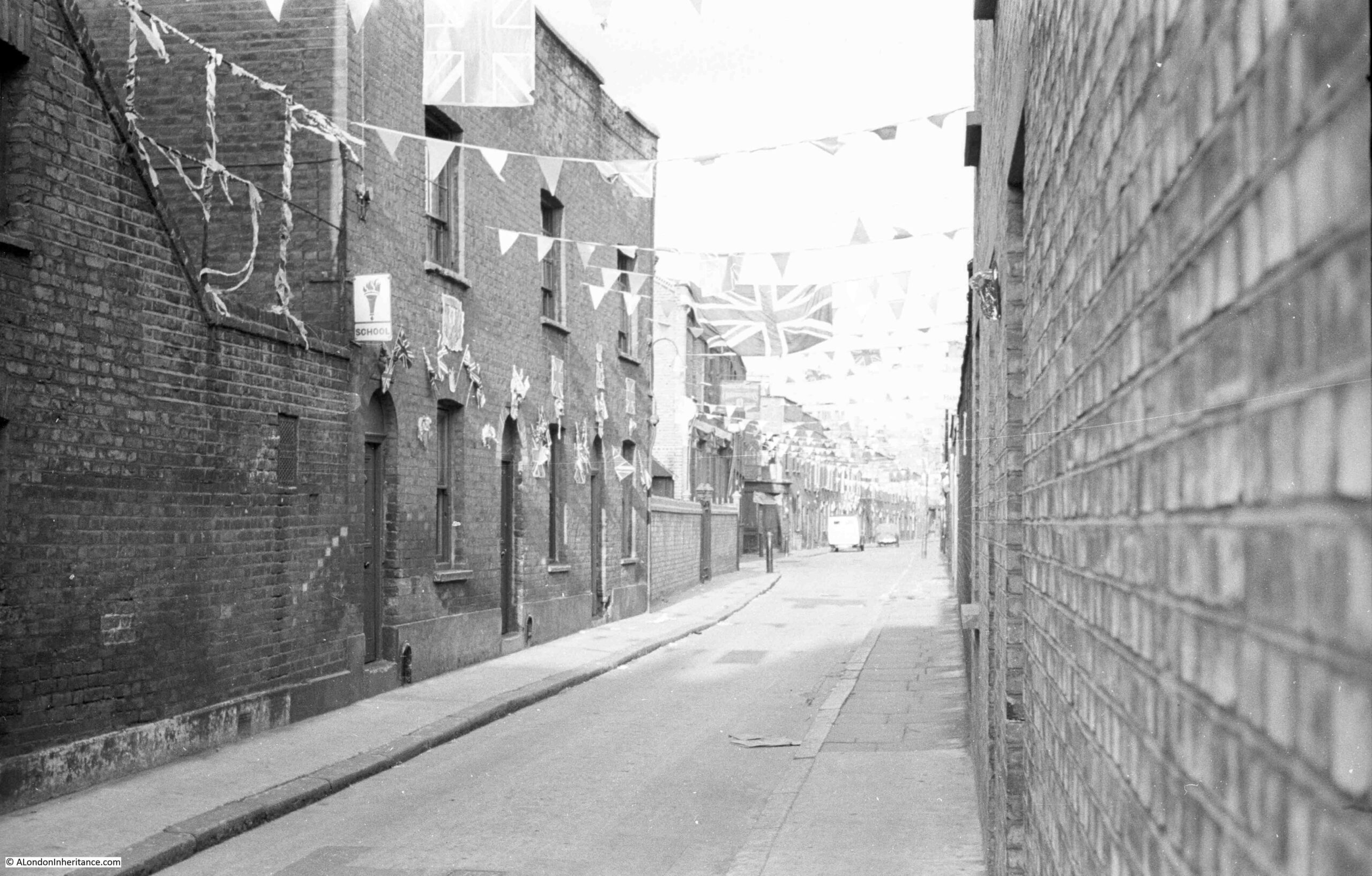
The same view today:

The following extract from the Ordnance Survey map was published in 1954, but surveyed in 1953, so the same year as my father’s photo. Ivy Street can be seen running left to right across the centre of the map. Hoxton Street is on the right, and at the junction of Ivy and Hoxton streets can be seen a building with numbers 241 and 243. The butcher’s in my father’s photo is number 241, and with 243 it must have been a double width building. The kebab shop today is number 241 (‘Reproduced with the permission of the National Library of Scotland“).

There are a number of features which confirm the location and can be traced today, which I have outlined in the photo below, starting the with red circle which surrounds the sign used in the 1950s for a school. As can be seen in the above map, there is a large school to the right of Ivy Street (in the direction of the photo). The school also has a playground on the opposite side of the street, and I have also marked these on the photo, with walls aligning with where the school and playground should have been.
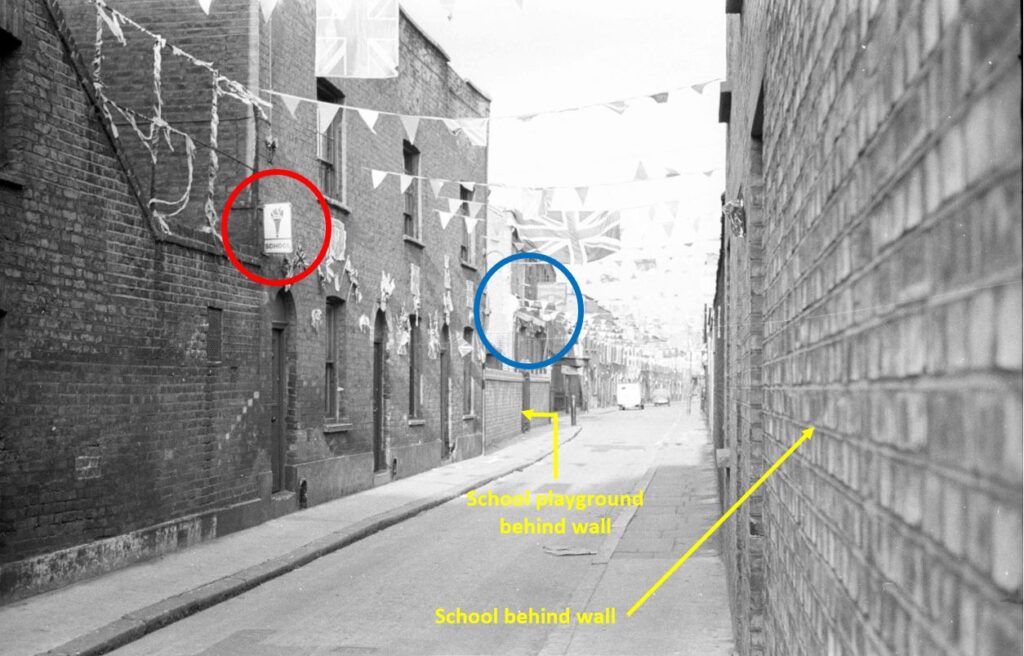
Further down the street, I have marked a feature in a blue circle. This is on the only building in the street that can be seen in the two photos:
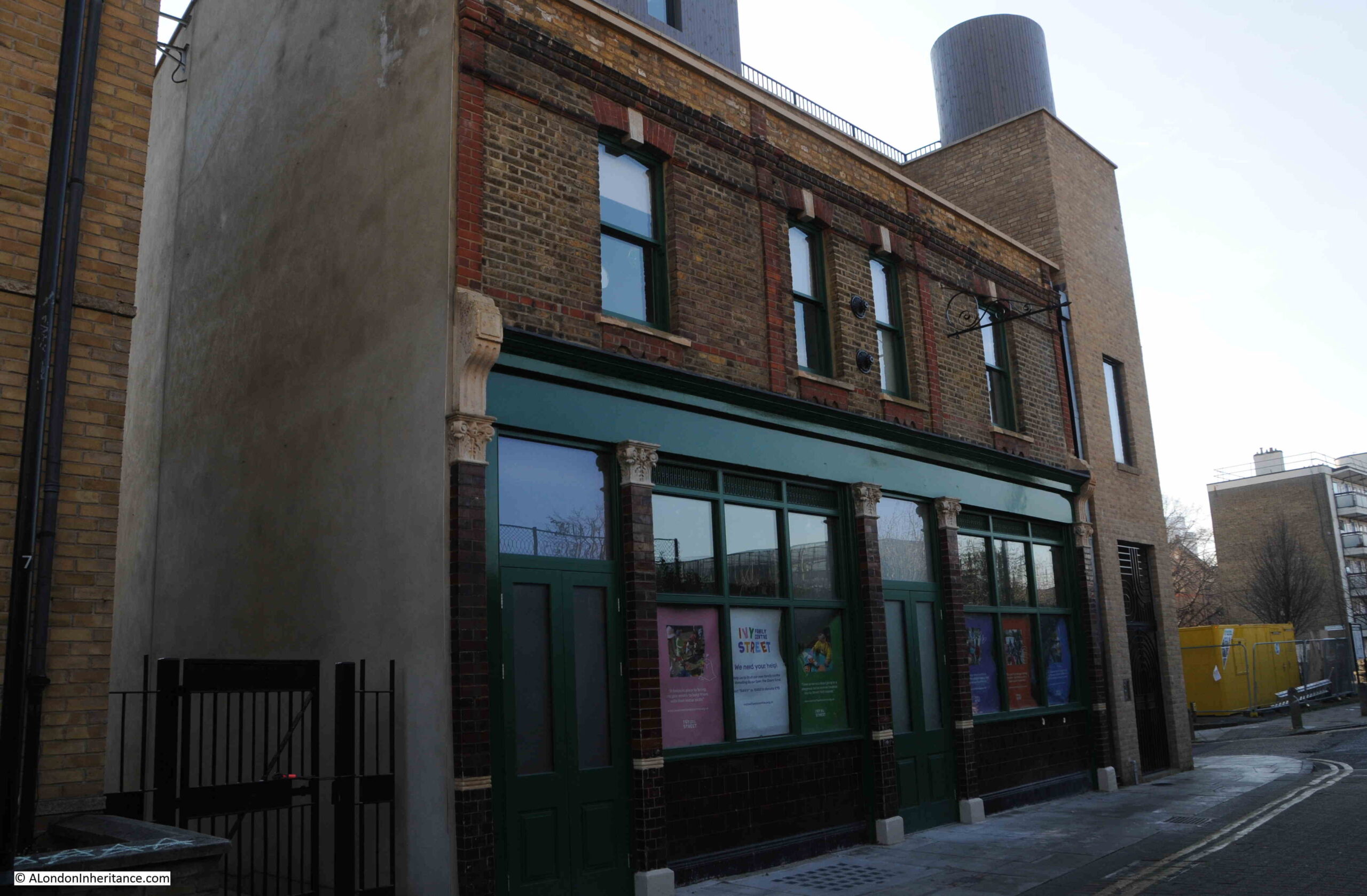
The feature in the blue circle is the decorative feature on the edge of the building, and the following comparison photos are an extract from the 1953 photo and 2023 photo showing the feature:

In the above 1953 extract you can just see a sign protruding from the building at top right. In my 2023 photo, the fixings for this sign are still on the wall.
The sign was a pub sign, as this building was the Queen Adelaide at number 54 Ivy Street. The PH in the OS map extract also confirms the location of the pub.
It is hard to date the pub. It does not appear to be that old as the earliest reference I can find date to the 1890s, when the pub seems to have been host to some rather strange competitions, as illustrated with the following from the Sporting Life on the 28th November 1891:
“BIRD SINGING – A LINNET handicap will take place on Nov 29th at 1.15, three pairs of birds, 6s prizes. Also a chaffinch handicap at 8.30 for 6s, three pair. On Saturday night, at 8.30 sharp, a chaffinch handicap. First prize, leg of mutton, second, shoulder of mutton; third, shoulder of mutton,; fourth, shoulder of mutton. open for all comers. Don’t forget – The Queen Adelaide, Ivy-street, Hoxton (five minutes’ walk from Haggerston or Shoreditch Station.”
And on the 22nd January, 1892:
“BIRD SINGING – LINNET HANDICAP. On the evening of the 17th inst. Mr. Ben Wilton, host of the Queen Adelaide, Ivy-street, Hoxton gave a handsome dinner service to be contested for in an open handicap, which was witnessed by nearly 150 persons. the coveted prize was won by Mr. George Everitt, whose bird achieved 4 score 10, Mr. Chilcott’s bird doing 4 score 6. The remainder of the evening was enjoyably spent, and brought to a most successful issue by a hearty vote of thanks to the popular proprietor.”
The Queen Adelaide closed in the 1960s and the building was acquired by Hoxton Community Projects. It is now home to the Ivy Street Family Centre, and there is a good photo of the old pub on their website here.
In the 1953 photos, it is just possible to see the street has a slight curve to the right. The alignment of the street is the same today, however just after what was the turning into Ivy Walk (after the pub) is the Arden Estate:

The following extract from one of the 1953 photos shows roughly the same view (I was just standing to the left of the street where I should have been on the right). The pub is on the left in both photos, and where the Arden Estate now stands, was a row of terrace houses:
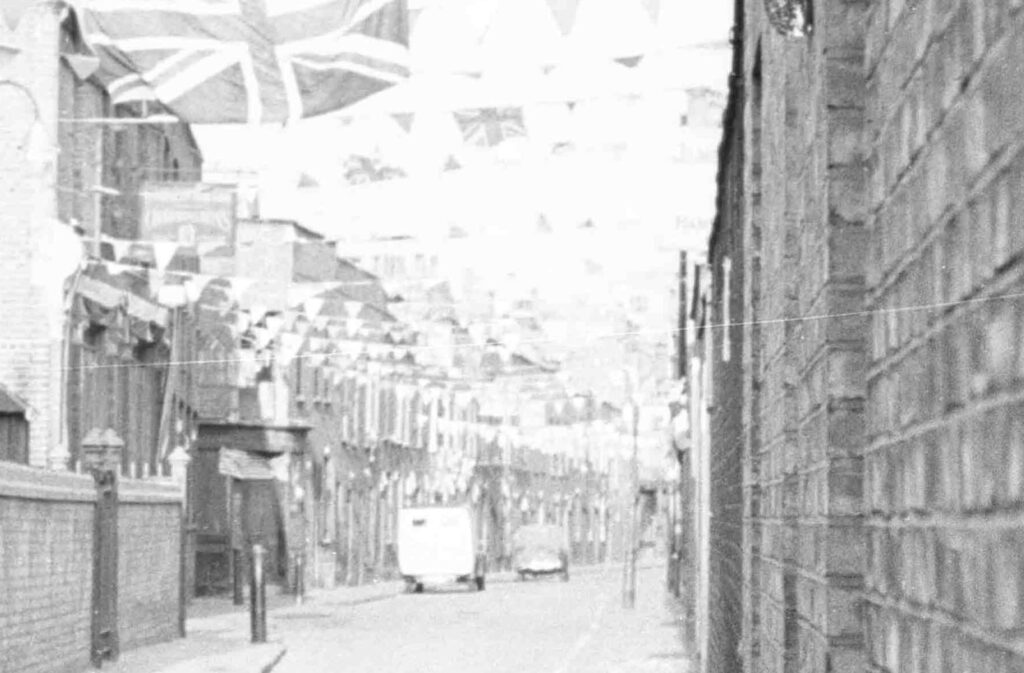
Reading reports of the activities in the pub over the years and seeing the photos of the decorated terrace street does illustrate the sense of community that must have existed in these streets, before being swept away with post-war rebuilding.
A clue as to when the buildings on Ivy Street at the junction with Hoxton Street were rebuilt are these stones on the wall of the building on the left of Ivy Street, indicating an original build date of 1842 (the building on the left of my father’s photo), and a rebuild date of 1963.

What I cannot find is whether this rebuild date also applied to the building on the right – the butcher in my father’s 1953 photo, and the kebab shop in my 2023 photo.
On the right of the Ivy Lane photos is a school, now the Hoxton Garden Primary School, which can be seen above the tall brick wall on the right of old and new photos of Ivy Street:

So, this is the correct location for my father’s photo. It could be that the new terrace on the right was built in the early 1960s when the building on the left was constructed.
What is interesting is the choice of construction material (brick) and design, both of which are broadly in line with the type of terrace houses that would have been in this part of London. If only far more post war rebuilding was as complimentary to the rest of the street in which they were built.
As with almost any London street, there were plenty of other interesting buildings close to where Ivy Street joined Hoxton Street, and the area will be a subject for a future post (I have already explored part of Hoxton in this post).
Almost opposite Ivy Street is this building – “Office For The Relief Of The Poor”:

This was the parish relief office which was part of the St. Leonard’s, Shoreditch workhouse complex that stretched from Hoxton Street back to Kingsland Road. Many of the buildings are now part of St. Leonard’s Hospital.
Opposite Ivy Street is the old Unicorn pub, now a Papa Johns Pizza shop:
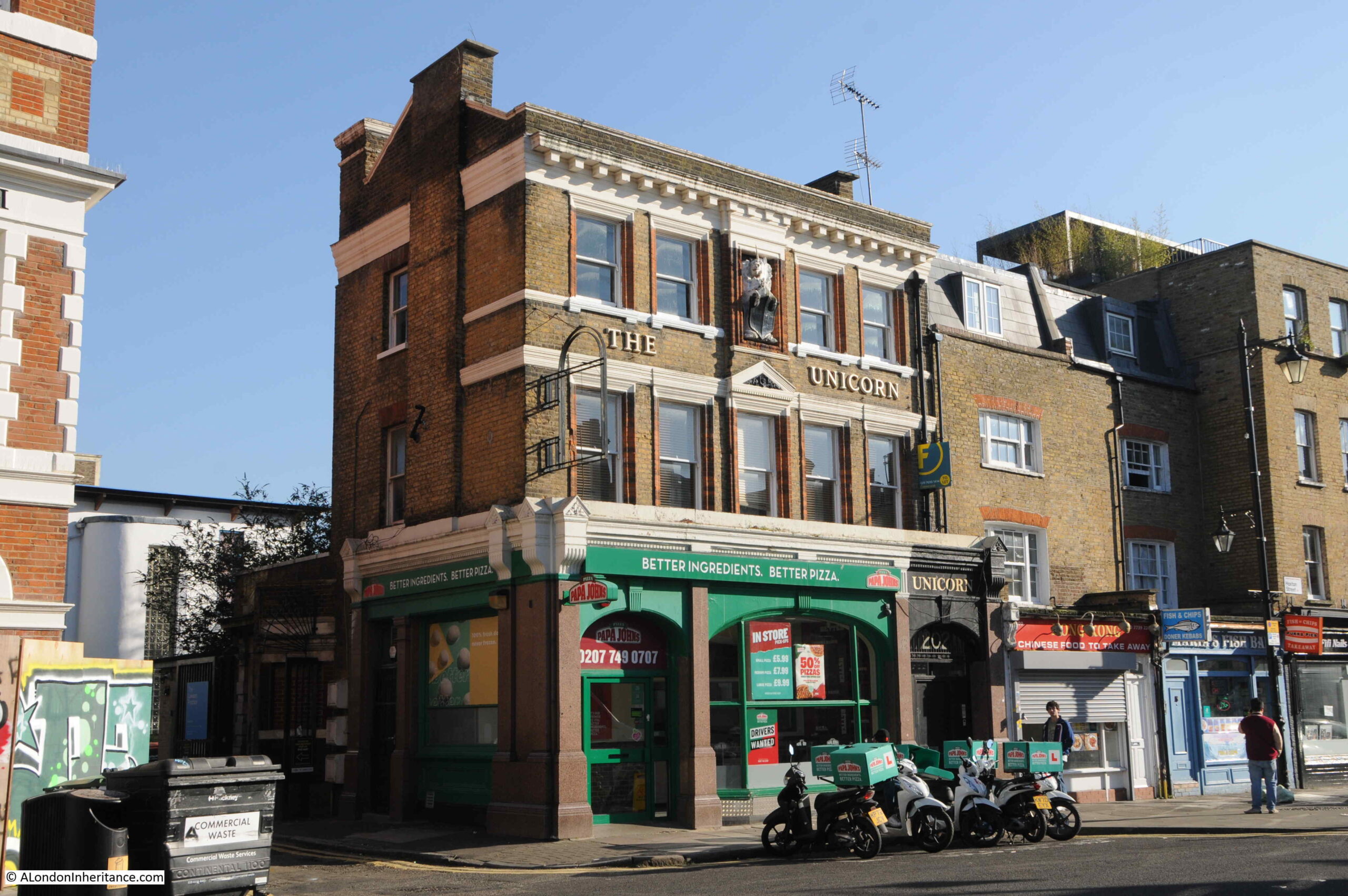
The Unicorn closed around 2008, and dates back to the very early 19th century. The first reference I can find to the pub is a report in the Morning Chronicle on the 9th of November, 1819, when there was a “DARING ROBBERY – Saturday evening, a little after dusk, some villains robbed the Unicorn public-house, Hoxton, by getting in at the one pair of bed-room window; they carried off a large quantity of wearing apparel, and a five pound Bank of England note.”
The name is unusual and does not seem to have any reference to Hoxton. There were so many pubs in London in the 19th century, and each pub would have wanted their own distinctive identity and name, so people could recognise the pub, and know which was their local and where they would meet friends.
As many people were illiterate at the time, graphical pub signs helped with the identification of a pub, and with the Unicorn, there is the added benefit of a carved unicorn and shield between the windows on the upper floor, leaving no doubt as to the name of the pub, even if you could not read the pub name.
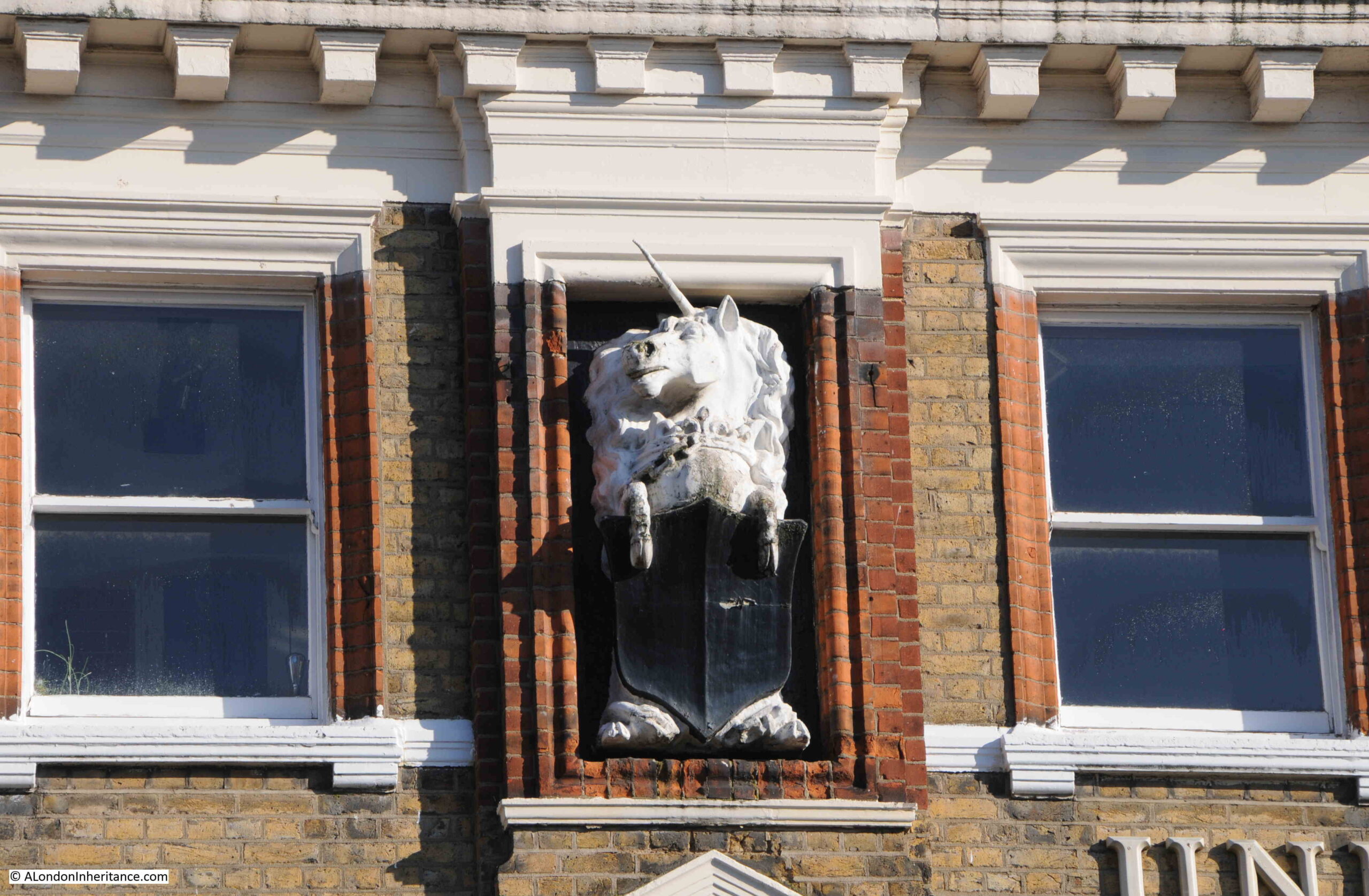
A very short walk away is another closed pub – the Green Man:
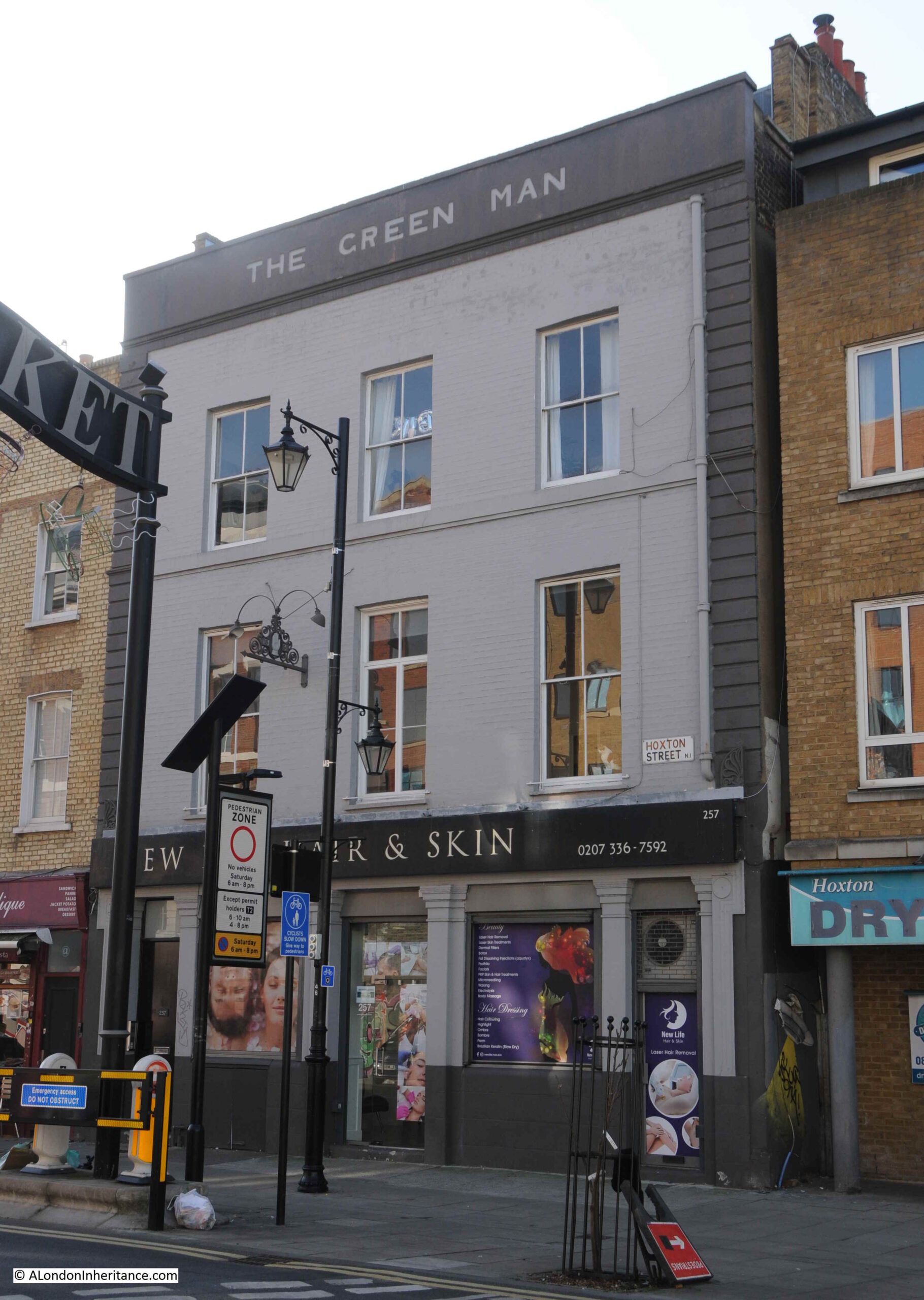
The Green Man appears to date from the 18th century. The earliest reference I found was in 1801, when the pub is used as a reference for a location, so was already a known landmark.
The article from the “Oracle and Daily Advertiser” on the 5th of February 1801 reads: “WHEREAS EDWARD SHORT left about two years ago SIX BOXES in the care and possession of Thomas Newman, at No. 1, opposite the Sign of the Green Man, Hoxton Town; if the said Edward Short does not remove said Boxes within fourteen days from the 5th of February 1801, they will be sold.”
The article shows how important visual references to a location were, when many people could not read and pub signs were key local reference points. I wonder if Edward Short did reclaim his six boxes?
There is the ironwork that once held the pub sign, still projecting from the Green Man. It has the hand symbol of the Ind Coope brewery, and the date 1856. This may have been when the pub was rebuilt, however I cannot find any confirmation of this, although strangely there are hundreds of news reports mentioning the pub in the 1840s and 1860, but very few in the 1850s, so perhaps it was closed for a while and rebuilt.
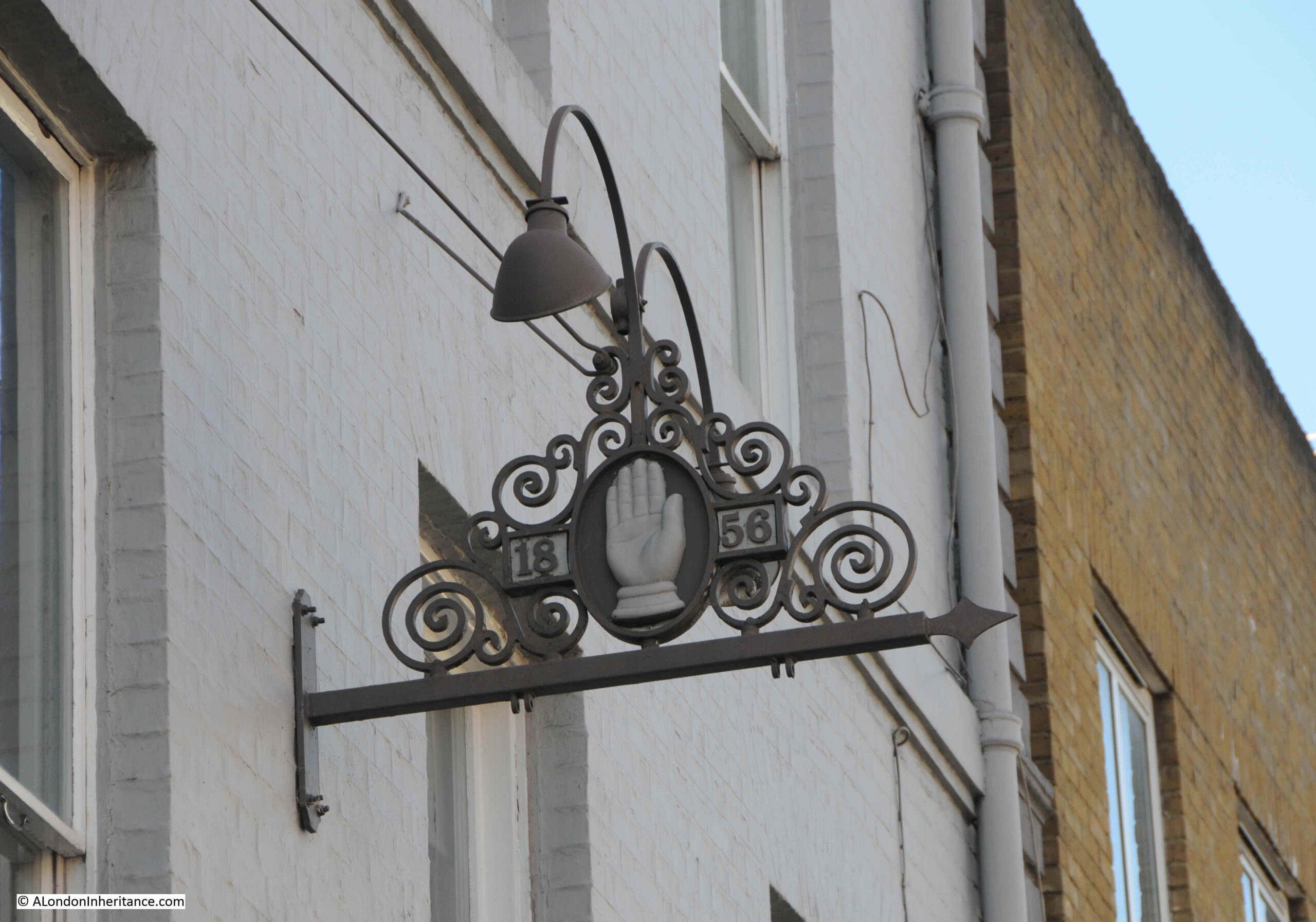
When I take photos of ordinary streets, away from the landmarks that are a common subject for photos, I often get a curious glance, and a look at what I am photographing – the person probably trying to work out what there is of interest that prompts me to take a photo.
Hoxton was the first time that I have been glared at by a cat, who did not seem to happy to be the subject of a photo:

When I was researching the photo of Ivy Street, I had nagging doubts over whether it was the right location, despite a large sign over the entrance to the street with the name.
It was just that the building on the right hand corner of the entrance today, looked pre-war, and very different to the building in my father’s photo.
Having now walked along the street, there are many other features that confirm it is the right location, and I suspect the brick terrace from the corner of Ivy Street and along Hoxton Street was probably built in the 1960s, so the mystery is not quite solved, however the choice of brick and a terrace design that would have been in keeping with much of the street has helped preserve the character of this part of Hoxton.

I love a mystery! Could it be the just the first floor of the butcher’s/kebab shop was rebuilt back to be part of an existing Victorian terrace? On closer inspection the ground floor is the same building as the 1953 photo because the brickwork matches but then you see directly above the ground floor and the brickwork is different! And there is a decorative panel added on the front of the shop. Also the shop to the left could also be a rebuild, as in the original photo the corner of the building is curved and decorative but in the 2023 photo it looks plainer. The whole building too, looks slightly different! Just my thoughts on this…Great blog as always!
Always interesting!
The date of 1856 on the former Green Man pub sign has nothing to do with the building. If you look closely, you’ll see that the date and the hand symbol are all part of the same logo, it being the description of Ind Coope, the brewery, which was incorporated in 1856.
I like the chinese vase in the front windows of the building on the left. So nice you can enlarge the pictures and look for details like this.
I hope you don’t mind, but I’d just like to further add that on closer inspection of the rest of the Victorian terrace, all the windows are ALL of the same traditional sash style rather than the hotch-potch of window styles we’d probably see now, in a parade of Victorian shops. There is also another floor added and the brickwork looks quite clean. Maybe all the upper floors of the whole terrace were rebuilt, because of a conservation order, but who knows. I’ve just really enjoyed looking at these photos, and making my guesses!
I went to that school in the mid-60s – it was called Burbage School then. I don’t think that the playground over Ivy Street was the school playground, as there was a big-enough playground (and a sports-ground-sized area where I took my cycling proficiency test) on the school side. I remember the shop on the corner opposite what’s now the kebab shop as a laundrette then. And the block with the kebab shop can be no older than the 1990s I think, but don’t know.
In the first photo, the building on the left has an inset and curved corner running from top to bottom, while the building on the right has a plain, sharply-edged corner. In the second photo, it is the right-hand building that now has the inset and curved corner, and the left-hand the plain and sharply-edged corner. The sequence of events must surely have been something like this: Firstly, the buildings on the right were demolished, to be replaced, unusually for the time, with a building which may well have followed the line and decoration of the left-hand building, including matching window-apertures. Then, the building on the left was replaced unsympathetically and presumably more cheaply, although, to be fair, the designer did maintain the same height of shop-front as on the right-hand side. An abiding memory of the fifties, sixties and seventies is that many things Georgian, Victorian and Edwardian were regarded as old-fashioned and overly fussy. The response was to replace buildings with structures that emphasised simplicity, resulting, when combined with post-war austerity, in much that lacked character or a clear inspiration. I’m glad that the present right-hand building survives in such good order.
This photo from the London Picture Archive is said to have been taken in 1977: https://www.londonpicturearchive.org.uk/view-item?i=187725&WINID=1676825458250. It shows the rear of 241 Hoxton Street with just two stories rather than the three stories that it now has. So the rebuilding couldn’t have been earlier than 1977.
My husband went to Burbage School too. He remembers the playground being on the same site as the school and he didn’t go across the road. He also recalls shopping nearby in Hoxton Street. He moved to Essex in 1964.
Thank you for the post. Always interesting
Hackney Council’s planning website throws a little, but not much , light on this. Hoxton St was designated a Conservation area in 1983, but unlike for more recently designated areas there is no area appraisal giving a detailed description of the buildings in the area. The description of the area covered does specifically include “ the former playground site on the south side of Ivy Street”. This is consistent with the memories posted above of it not being used by the primary school. There is one planning application shown for 241 Hoxton Street. This was for a change of use for hot food takeaway (class a3) with formation of a new doorway onto Ivy Street and erection of extractor. It was submitted in 1996 and approved in January 1997, giving a date for the change to kebab shop. Earlier applications have not been digitised so we can only narrow down the date of the rebuilding of 241 and the adjoining properties to between 1977 (London Picture Archive photo) and 1996.
Hi always enjoy these ramblings! There is a village called Queen Adelaide in Cambs. Perhaps after a pub?
Dear Mr Blogmeister
I can’t find a way to communicate direct so can I say here how excited I would be if you could share more of your dad’s 1950s photos of Hoxton. Just a decade before I moved there and so surely full of interest for me, and it looks like a few others too. Thanks.
Vastly changed area -for the better?
I went to Burbage school from 1971 to 1978. The playground oppesite by then was a derelict waste land. All the terrace houses at the back along Ivy walk were gone, but Ivy walk remand there for years, cutting through under houses to Hoxton street, I was always fascinated by that and was saddened when it was finally demolished to make way for the Co-op, which also has now been demolished.
The building on the right of Ivy street had renovation work done to the upper part and roof top. I can not say when this took place but on that roof top was what I always thought a spooky chimney, I think it was a metal airvent, like the ones you get on ships. It was a rusty old thing and it would turn round, I guess from the wind and when it did it made a strange hollow rattle when it did…I can hear it now!!
From the school playground you could see it and the fact it it would move round made me believe there was something eerie about it.
Then some years after – late 80s early 90s maybe, it was gone and I realised the whole top of that building had be renovated.
So that is the original building from your fathers photo, but looking at your 2023 photo, my recollection of that rooftop was never that flat or smart, or that high!
A great article with quality photos.
Cheers.
Thank you – This is fascinating.
We lived on the Cranston Estate and I remember playing in that playground while my Mum shopped in Hoxton. There was a parke keeper in a brown uniform who kept an eye on the place.
My mum (June Crouch) was born in Ivy street and she often spoke so fondle about Ivy street and surrounding areas. I went to Ivy St in November 2024. Makes me feel very close to my family!
Donna
Facing the entrance to Ivy Street from Hoxton, the shops would have been Victorian prior to WW11. The corner shop to the right was bomb damaged and replaced by a fletton faced brick structure just after the war. This rather boring box like building is the one in your fathers 1950;s image and was occupied by butchers H Allwrights. The remaining collection of shops up to the shop adjacent to the Green Man PH was demolished in the late 1970’s and replaced by 1980 by the uniform pseudo Victorian shops that exist today. The shop adjacent to the ‘Green Man’ was a bomb site plot until the early 1970’s when the current structure was built. The only existing ‘Victorian’ building to survive is the pub itself which dates to the early 1800’s, although its frontage and pediment has changed over time. The St Leonard Hospital frontage is the only part of the building to have survived, literally the front wall. The remainder of the building behind has been totally renewed as has the adjoining nurses quarters which replaced the original Victorian hospital. Change does not always result in improvement.
Incidentally, the shops which were demolished in the late 70;s included a cafe (closed by this time) which had been run by the Andretti family for many years. Boxer Vic Andretti , a Hoxton boy through and through, died in 2018